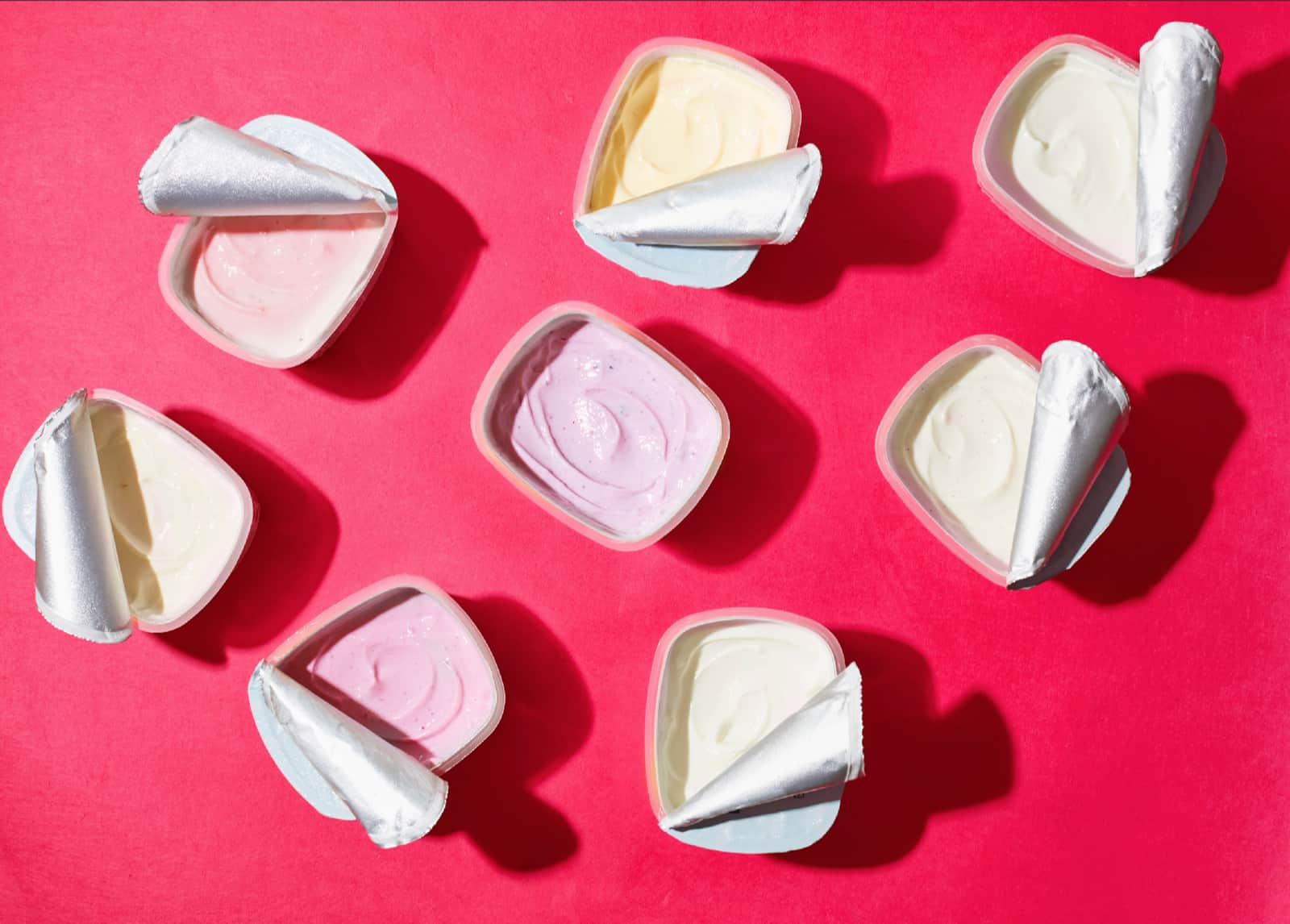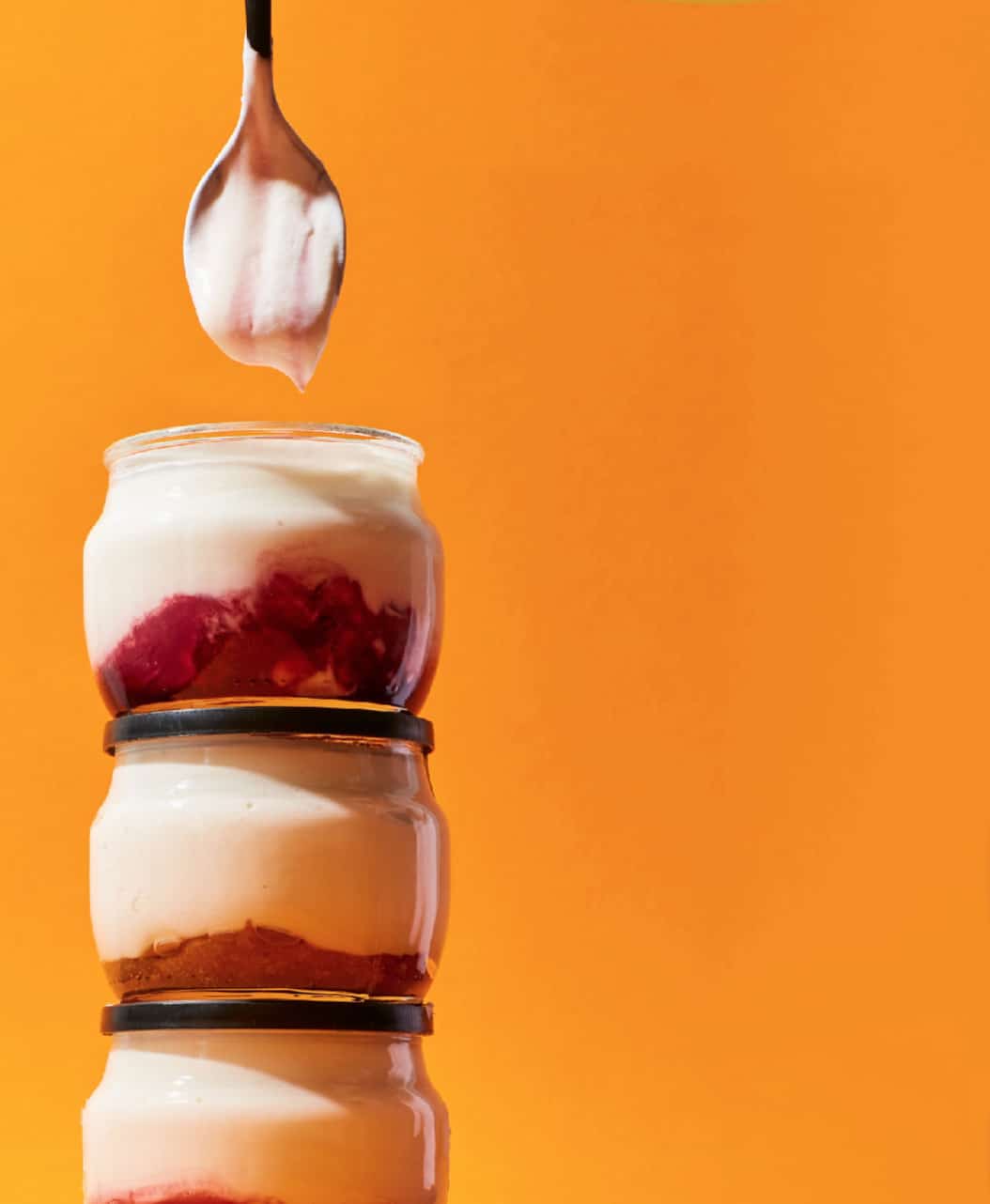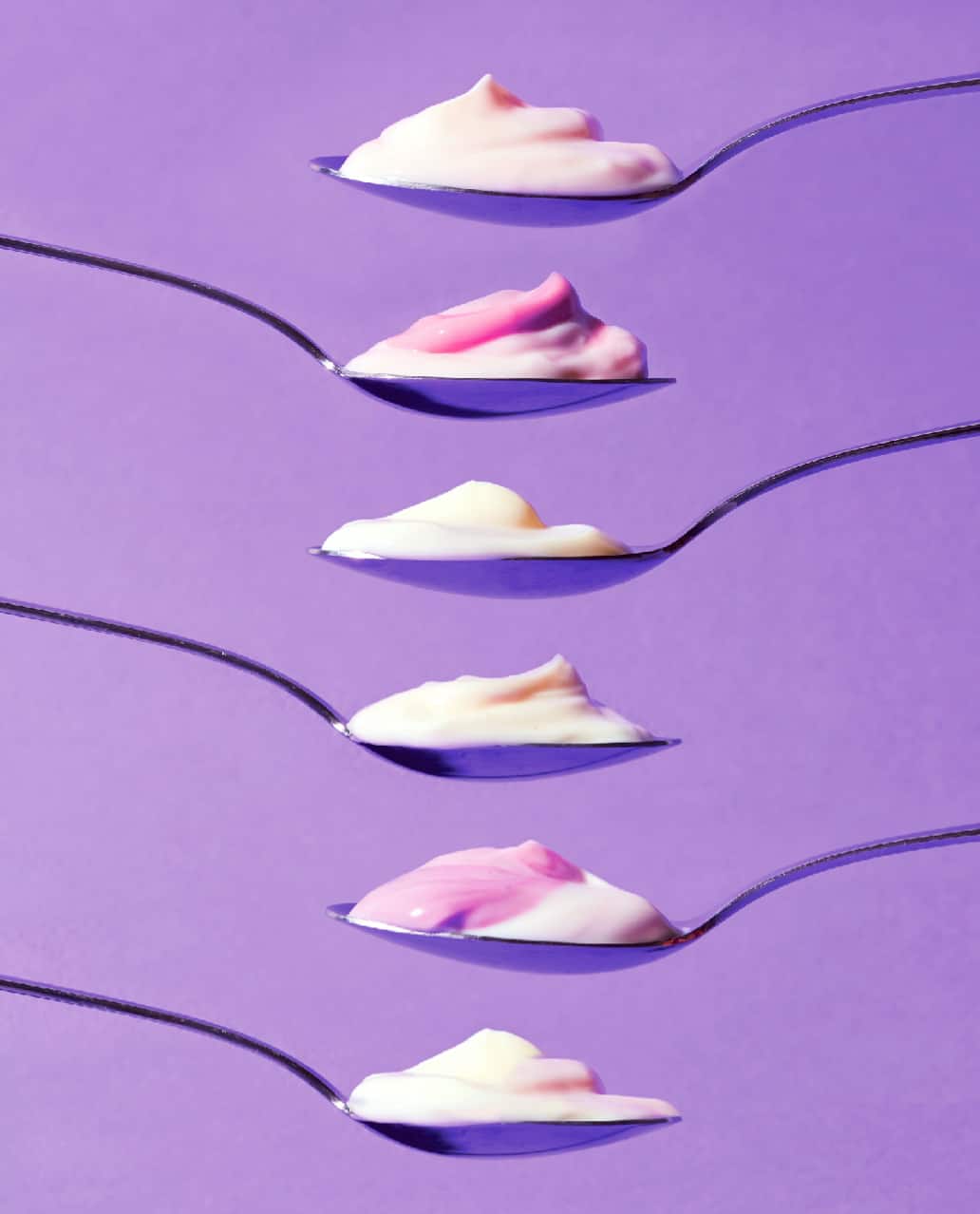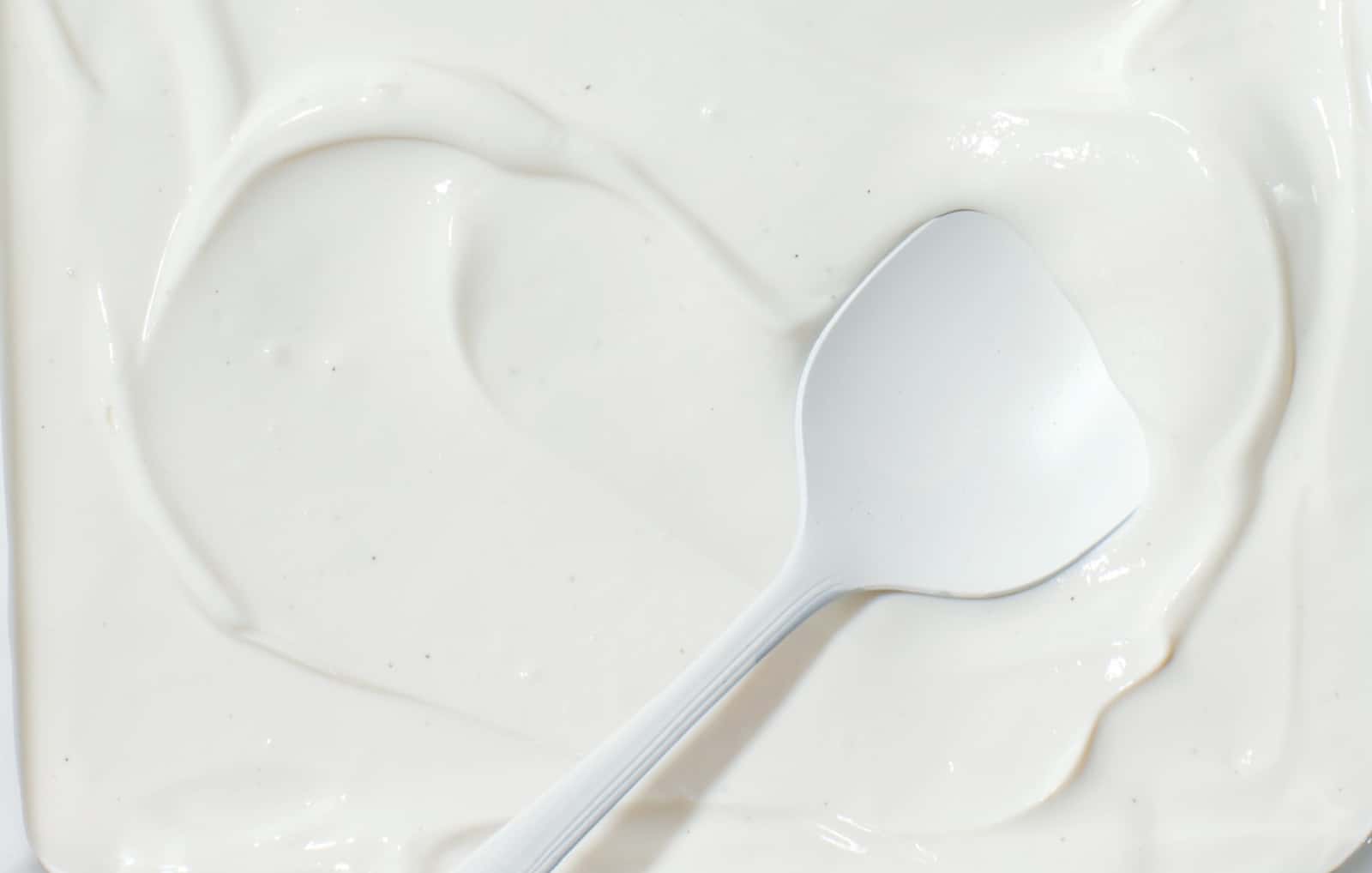
My earliest memories of yogurt date to a ’90s-era cafeteria: the friend at the lunch table who, without fail, would pluck a plastic container from her insulated bag, then lick the label clean. Finding its sweetness cloying and its thin texture unsubstantial, I reached for the stuff only on rare occasions—more to up my calcium intake than to satiate a craving.
These days, though, I see yogurt in a whole new light. I savor modern vanilla-speckled versions as dessert and incorporate tart, plain styles into meals. No longer thin, goopy, and sugar-laden, yogurt has entered a new age in America, showing off trimmed-down ingredients, sophisticated flavors, and a new range of varieties. These days, US makers are drawing from a breadth of global traditions—from France and Russia to Iceland and Iran—and consumers aren’t looking back.
What is yogurt? Yogurt is milk—usually cow’s milk in the United States—that has been fermented by bacteria: at the very least Lactobacillus delbrueckii and Streptococcus thermophilus, but other strains can be used, too.
Cream of the Crop
In 2000, the average American only ate six and a half pounds of yogurt per year, but by 2005, the cultured dairy was seeing steady growth. And then, the sweet spot: Since 2010, yogurt consumption has hovered between 13 and 15 pounds per person. So, what happened? Our skyrocketing demand for yogurt went hand in hand with the mid-aughts rise of the Greek style. (Greek import Fage joined our ranks in 1998 and Chobani was founded in 2005.)
A 2011 UBS report revealed a 146 percent increase in Greek yogurt sales between 2010 and 2011; during the same period, traditional yogurt sales grew by only two percent. What drew us to Greek, the report concluded, wasn’t just protein, but its ability to satiate: Unlike traditional yogurt, Greek could be the base of a full meal, not just a snack.
With all this sudden interest came a changing of the guard. In 2016, Yoplait, once the top-selling yogurt brand, fell to third behind Dannon and Chobani. In 2017, Chobani rolled out a rebrand in response to their gads of competitors flooding the market. Once the new kid on the block, Greek has reshaped our idea of what yogurt is, and as it shifts from underdog to mainstay, consumers’ tart-accustomed taste buds have begun to hunger for novel options.

Icelandic Provisions Skyr
A World Tour
A peek into nearly any grocery store’s dairy case yields a range of yogurts claiming ties around the world. While these new options might leave us scratching our heads, the difference boils down to the bacterial cultures in question, and whether the yogurt is strained or unstrained. (Greek is typified by straining; removing most of its whey creates its iconic thick texture.)
Fundamentally, yogurt is made by adding the bacterial strains Lactobacillus delbrueckii and Streptococcus thermophilus to milk that has been warmed, but other strains can be added as well. Once in the milk, the live, active cultures consume lactose and turn it into lactic acid, producing different flavor profiles and clumping milk proteins to form a range of textures.
But how does that resulting variation play out on the supermarket shelf? Icelandic-style yogurt, sometimes labeled “skyr,” is one variety gaining popularity. According to Steve Platt, CEO of New York–based Icelandic Provisions, the company’s skyr is characterized by the use of heirloom cultures, which lend a rich, creamy quality and tie the product to Icelandic food traditions. Skyr is strained, so it’s thick and firm, and while there’s a touch of tang, it trends toward natural sweetness and doesn’t require much added sugar. Flavors veer Icelandic, too, highlighting fruits like lingonberry and cloudberry.
Or, you might fall for French style, a dessert-like yogurt with no tart aftertaste. Jenefier Wickham, assistant manager at Oklahoma’s Amelia Creamery, attributes their yogurt’s decadence to French probiotics and the retention of whey, which creates a runnier consistency. Its packaging swings European as well: Ceramic jars keep the product safe from light and recall French tradition. (Yogurt giant Yoplait also has a line of creamy French-style yogurts sold in glass jars—called “Oui,” the treats are a nod to their early years as a dairy cooperative in France.)
Head east on the yogurt map, and you’ll find Greek, Middle Eastern, and Russian styles. California-based Pavel’s has made Russian-style yogurt since the 1970s using a 100-year-old recipe that relies on culture strains with roots in Siberia, where the company’s namesake once had a dairy farm. Luke Sortor, who took over the family business in 2005, describes the yogurt as “high umami and low acid.” Because of their distinct collection of cultures, he says, Pavel’s is more delicate than other varieties.
In Brooklyn, micro-producer White Moustache crafts Greek and Persian yogurts—though, to owner Homa Dashtaki, it’s all a bit of a misnomer since so many cultures follower similar yogurt-making traditions. For her, the distinctions mainly signify strained versus unstrained. “Your North American home cook is making Persian yogurt, as far as I’m concerned,” she says of the unstrained style. One product of Dashtaki’s is culturally specific, though: moosir, an unstrained yogurt to which she adds Leopoldia shallots. “Shallot yogurt is one of the most quintessential Iranian foods,” she says, adding that yogurt offers more options if it’s seen in a savory light (in the Middle East, it’s often used as a condiment and soup base).

White Moustache Yogurt
Small and Simple
While cultures and styles vary, a common thread among smaller producers is a commitment to simplicity. For some—like Greek-American Steven Ioannou, co-founder of Long Island–based Nounós Creamery—going back to basics forms the entire foundation.
Before the Greek yogurt boom, he says, his family made yogurt at home, letting whey drip into the kitchen sink as they strained the yogurt with cheesecloth. When the style gained popularity, he says, “We were really excited that we could just buy it.”
But Ioannou was quickly disappointed by what he saw as the pitfalls of large-scale production. “They were adding a lot of sugar. It was more of a treat than a healthy snack,” he says. After a trip back to his family’s village in Greece, he and his godfather—now his business partner—decided to carry on the tradition: minimally processed, handmade yogurt without preservatives or fillers. “The yogurt that we make [in Long Island] is the same yogurt that we made in Greece,” Iannou says.
Wickham of Amelia Creamery tells a similar tale. When founders Tony and Maria Barros moved to the United States from Brazil over 20 years ago, she says, “They couldn’t find a yogurt like what they knew—that was natural, that tasted good, and that was really good for your gut.” So, Tony, a pilot by trade, began visiting France regularly to learn traditional techniques. He started crafting yogurt using whole milk, raw cane sugar, homemade jams, and French cultures for family and friends; it earned so much acclaim that the family launched the creamery in 2017.
These sentiments are echoed by many small producers, who see their niche as small-batch yogurts with minimal ingredients. They eschew the over-involvement of machinery: “The cultures aren’t shocked and [nothing is] over-processed,” says Iannou. Largely, they forgo a reliance on fillers, thickeners, and preservatives, instead letting cultures and time work their magic on milk. Many, too, are trimming down sweeteners—the drive, they say, is a growing desire for more stripped-down foods. Drawing from his decades of insight into the yogurt industry, Pavel’s Sortor says that “people are looking for cleaner ingredients…the consumer is looking for something that’s much simpler.”
Widespread distribution is often not the goal. To White Moustache’s Dashtaki, staying small has yielded the best results—the company capped itself at 35 stores and chooses not to distribute anywhere over 20 miles away. Not worrying about becoming big allows her to take her time. “Letting the process lead the way lets us innovate,” she says. “Every batch feels like a magical baby, and we get to linger in that.”

Noosa Yoghurt
Tasting Notes: Yogurts from Around the World
Yogurt has ties to global food traditions that extend far beyond what we can find in the US, but to keep it simple, here’s a rundown of the common options on stateside grocery-store shelves.
Greek
Known for its high protein content and pronounced tang, Greek yogurt is strained to remove a substantial amount of whey, leaving a thick, dense texture.
Try: Nounós Creamery Greek Low-Fat Yogurt
Icelandic
Compared to traditional yogurt cultures, skyr cultures (plus straining) yield a rich mouthfeel with a stick-to-your-spoon texture and natural sweetness.
Try: Icelandic Provisions Skyr
French
Forgoing straining results in a lighter, creamier style containing more whey. More dessert-like, it trends toward sweetness instead of acidity.
Try: Amelia Creamery Natural French-Style Yogurt

Nounós Creamery Vanilla Bean Blend
Persian
This unstrained style has a looser consistency, lending itself to savory preparations like sauces or dips. Traditional mix-ins include cucumbers and shallots.
Try: White Moustache Savory Shallots Yogurt
Russian
Russian-style yogurt has a delicate texture, mild flavor, and low acidity—which means it’s easy to eat alone, and doesn’t overpower when mixed into recipes.
Try: Pavel’s Plain Original Whole Milk Yogurt
Australian
Think of it like the midpoint between Greek and traditional: Australian “yoghurt” has a firm yet velvety texture and subtle sweetness.
Try: Noosa Yoghurt
Whey to Go

The acidic liquid that’s left behind when yogurt is strained, whey has been called Greek yogurt’s dark side. Why? Makers almost always end up with too much of it, and since it can leach oxygen from waterways as it breaks down, it’s illegal to dump. Unlike the whey leftover from cheesemaking, yogurt whey is too high in acidity and too low in solids to be turned into protein powders. Instead, it often ends up at farms as feed or fertilizer.
According to White Moustache’s Homa Dashtaki, however, it’s a shame for whey to go to waste. She sees whey as drinkable magic, so she bottles it into tonics—from plain (great for brining chicken) to passionfruit—and freezes it into popsicles. “You want to swim in it with a straw,” she says of the nearly luminescent yellow liquid.
Though she notes that bartenders have worked with whey for years (it can be used as a egg white alternative in cocktails), she laments the current lack of interest in drinking pure liquid whey: “It’s a fascinating and delicious byproduct and it’s everywhere, so it’s shocking that it’s not an ingredient staple.”
Header image: Amelia Creamery Natural French-Style Yogurt
Photography by Evi Abeler
Styling by Nicole Twohy



